#Dead Island: Epidemic
Text
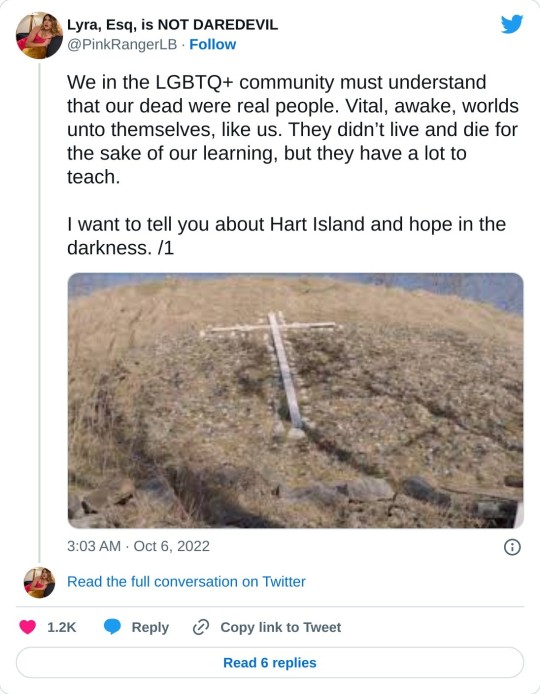

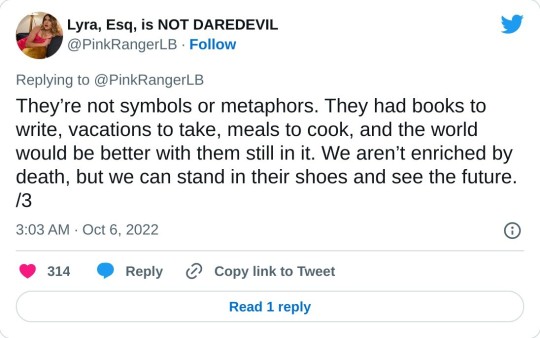
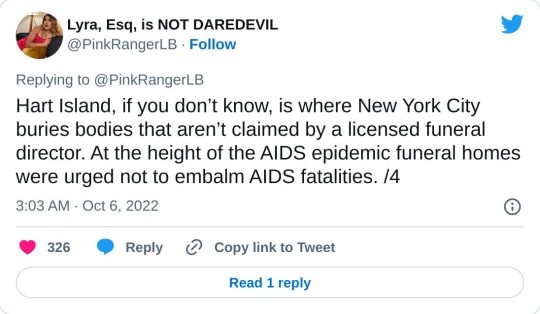


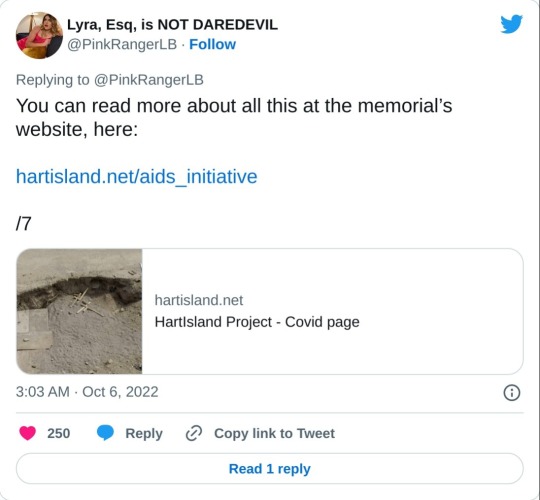







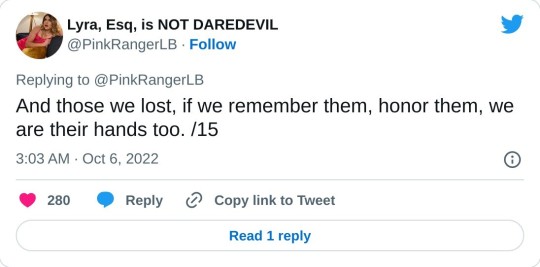
ID: A thread of tweets by PinkRangerLB, a trans lawyer, that say the following.
"We in the LGBTQ+ community must understand that our dead were real people. Vital, awake, worlds unto themselves, like us. They didn’t live and die for the sake of our learning, but they have a lot to teach.
I want to tell you about Hart Island and hope in the darkness. /1
When I say they were real people I mean I do not believe they are necessary sacrifices, or that our dead paid a cost for us. They loved, they feared, they had favorite TV shows and candy bars. They were here and it will never ever ever be okay that they’re gone. /2
They’re not symbols or metaphors. They had books to write, vacations to take, meals to cook, and the world would be better with them still in it. We aren’t enriched by death, but we can stand in their shoes and see the future. /3
Hart Island, if you don’t know, is where New York City buries bodies that aren’t claimed by a licensed funeral director. At the height of the AIDS epidemic funeral homes were urged not to embalm AIDS fatalities. /4
In New York, as elsewhere, stigma toward the queer community was at a level that even now it can be difficult to remember. Many queer people who died of AIDS had been disowned by their birth family because of their identity, their HIV status, or both. /5
To make matters worse, their partners and found families had no rights to their medical care or their bodies after they passed. The hateful families that could claim them often didn’t, and the families that loved them were powerless to see to their wishes. /6
You can read more about all this at the memorial’s website, here:
hartisland.net/aids_initiative
/7
You can feel their weight, can’t you? The absence is heavy. And it’s important we understand that weight, because it’s a flat fact that current attacks on LGBTQ+ rights, trans rights especially, will kill people. There will be more absence, and it is not okay. /8
And when we say we have hope we are not saying it’s okay that they will be gone.
None of this ignores intersectionalism, higher rates of infection in targeted communities, death rates higher still. When I say things *can* get better I am not ignoring that improvement favors /9
the privileged.
Things got better. ACT UP and other activist groups organized and gained ground through community building, mutual aid, and grassroots action. Culturally, the tide began to turn. Federal action by Reagan and then Clinton contributed very little /10
(and in fact often caused harm). Direct action by activists galvanized AIDS research and the tide turned with very little government help.
In New York City, the death rate for HIV/AIDS patients fell by 62% from 2001 to 2012. So here’s what I’m saying. We’ve been seeing /11
an escalating backlash against LGBTQ people for years now. It gets very easy for us to come to expect the worst case scenario. Trump won, states are attacking trans kids, Roe was overturned. So now we say WHEN the Supreme Court overturns gay marriage, WHEN a national /12"
abortion ban passes, WHEN trans healthcare for adults gets criminalized.
And don’t get me wrong, those are all very real threats. We have to fight like hell. I am not pretending that times aren’t dark, that people won’t die, or that it will ever be okay that our people will /13
suffer and die. But things can, and do, get better when we fight, when we look after each other. The tide will not inevitably turn, but *we* can turn it. We can say that when the wall finally fell, our hands were there, pulling it down brick by brick. /14
And those we lost, if we remember them, honor them, we are their hands too. /15"
#lgbtqia+#trans rights#transgender#activism#lgbtq#queer community#queer activism#lgbt#queer history#AIDs Crisis#you should share more of her threads on here they are often this anti-defeatist#I've been trying to use twitter less and go to tumblr more to get away from twitter's defeatism#I don't want any of you to start importing and accepting that defeatism here
369 notes
·
View notes
Text
Books I Want Adapted By Mike Flanagan
*Note: I haven’t seen all of his work and I’m more of a mystery/crime fiction reader than horror*
Something Wicked This Way Comes:

I think this is probably the most expected considering it is THE Halloween story that people suggest. It is about two friends' experiences with a dark traveling carnival that preys on people’s desires right before Halloween. Ray Bradbury has written plenty of horror short stories as well that would supplement this as Flanagan sometimes incorporates those into his adaptations.
Death of the Living Dead:
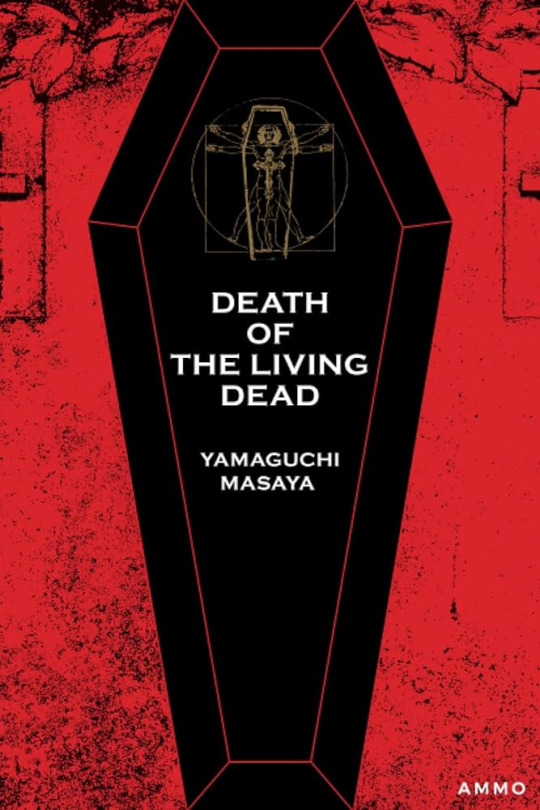
Translated from Japanese, beware the English print is very tiny. This is a story of a funeral director family living in New England in the 80s. The Barleycorns are a troubled family but what could be more troubling for funeral directors than an epidemic of the dead coming back to life? Murder, but why murder when the dead come back to life? It is a murder mystery that plays with the classical conventions of a mystery novel.
The Woman in White:

A ‘sensation novel’ written 1859. After a mysterious encounter with a woman in white Hartright, an art teacher, and his students find themselves absorbed in a tale of intrigue, suspense, crime, and more. The story is told from multiple perspectives which was inspired by how a crime is described by multiple witnesses in court. I think a lot of Collins’ novels could be adapted or they could be used for inspiration like I said with Bradbury.
Another:

Another (ha) book translated from Japanese. It has an anime and film adaptation as well but I haven’t watched either. Koichi transfers to a new middle school but after realizing everyone is on edge and ignoring a girl who looks like a doll he figures out he is in a cursed class and a chain of horrific deaths follow. He tries to get to the bottom of it all and stop the gruesome deaths. There are three novels in this series but I only have the first one, I want the other two.
Wylding Hall:

Members of an “acid-folk band” meet up at an old mansion in the country to record their music. They make their album but their lead singer goes missing in the building and is never seen again. Years later, the band reconnects with a young documentarian to tell their stories of what happened that summer.
And Then There Were None:

It doesn’t necessarily have to be And Then There Were None by Agatha Christie but any of the numerous mystery novels inspired by it. An island or secluded area where a group of people are staying with no contact to the outside ( A closed circle/community mystery ) and the people are dying off one by one as they try to figure out who the culprit is.
*I kept the descriptions short intentionally for convenience, so if you want to know more look them up, comment, or message me. I’m not going to promise to answer but I will try. If there are a lot of questions about one title I’ll probably just do a big singular review post of that title.*
#mike flanagan#intrepid pictures#the fall of the house of usher#edgar allan poe#the haunting of hill house#the haunting of bly manor#the midnight club#film adaptations#book adaptation#book recommendations#bookish#booklr#books#bookworm#books and reading#bookblr#literature#reading#bibliophile
40 notes
·
View notes
Text
Crossover Universe Maps and some Lore
I finally got around to writing some Lore about my Crossover Universe. I have to say that it will change over time, because I have constantly changed it over the years.
I admit that there won't be much, such as the whole history and culture, because I probably can't do good worldbuilding, I mostly do it for fun. Still I'm still ashamed of it...
I also have to mention that most of the islands have some parts of the lore of my favourite video games (since it's called Crossover Universe of course :P).
So anyways... Enjoy? ╮( ̄~ ̄)╭
The Crossover Universe is actually a multiverse that connects several alternate universes in order not to damage their main timelines.
Planet Thansuokria:

The new residents named the planet Thansuokria, which was said to be larger than Earth. This water planet has several islands separated by stormy oceans. No one knows why individuals from any universes and timelines end up here. For some it's a great change, for others it's a disaster and they wish to return. Some think that Thansuokria may be an afterlife, as most of the residents have arrived shortly before dying or falling asleep, but this is largely denied.
Here is a smaller part of Thansuokria where the story takes:

Islands:
Azerwias (Warcraft) - The largest diverse island, the main residents of which are from Azeroth, Outland and Draenor. Relations between the Alliance and the Horde are usually very tense and they try to gain as much territory as possible. Nevertheless, both sides were able to make a peace agreement, but it is not known how long it will last.
Cross Island (Assassin's Creed) - An island owned by the Templars and Abstergo as the main base and ruled by a dictatorship. The Templars manipulate the Alliance so that they can eliminate their enemies easier and gradually expand their Order to other islands. Either way the Assassins try to stop them…
Fouria (Left 4 Dead) - Originally it was a holiday island, until one day an epidemic broke out there causing a zombie apocalypse. Today it is a strictly forbidden place where experiments are carried out to eliminate the virus. Fortunately, the virus did not spread further and a vaccine was even invented, which created immunity in the vaccinated. But the vaccine could no longer help the infected and new mutants were created from them, which managed to leave the island and reach other areas.
Mann Islands (Team Fortress) - Islands with an endless war between two companies RED (Reliable Excavation Demolition) and BLU (Builders League United). The arms company Mann Co located in it's city makes money from their war, but is even interested in doing business with the Alliance and the Templars, the Horde considers them as dishonest cowards. RED and BLU have mercenary teams that attack each other to get the rarest resources to make their products. Most mercenaries enjoy their jobs for the money and/or even the enjoyment of the combat, though there are exceptions who are there involuntarily.
Whirlsand Ruins (Warcraft, little bit) - A desert island that is impossible to live. This place is the main home of the bronze dragons guarding the center of the island. Some believe they guard timetraveling portals, as the bronze dragons of Azeroth are known for traveling and protecting time. It's still a mystery…
Pure Kingdom (OFF) - A mysterious island inhabited by humanoid beings called Purifiers who may have a probable connection to The Batter. Their kingdom isolates itself from other factions and refuses to form alliances or create wars because they consider them as impure. Rarely, red-eyed individuals have a curse that allows them to turn into a monster and threaten their surroundings. They are often exiled for this, as the Purifiers believe that the curse can spread among others and hope that the exiles will perish beyond the borders of their kingdom. But it's not always like that, and the cursed Purifiers can find a new home in an unknown world…
Island of Eagle (Assassin's Creed) - The hidden island of the Assassin's Brotherhood, where they only live in the secret small town Accipiteria and the rest of the island is wilderness, so that their archenemies the Templars will never find them. It had been going like this for a many years since they entered that world, unfortunately one day they were attacked by the Templars, destroyed their town and captured or killed several Assassins. The survivors managed to escape in the south to safety.
Havaykia (Crossover, made this island since childhood) - An isolated island that rebuilds a sanctuary for those who have fled their homelands and can live here in peace. It is mainly known for the diversity of inhabitants from other islands living in harmony and the exotic colorful wildlife. Since Havaykia does not support wars and colonization, several factions are still interested in getting this territory for themselves, but the inhabitants of the island defend their rights to freedom.
Oceans and Seas:
Waves of Silence - It got its name from the waves, which for a mysterious reason cannot heard any sounds.
The Proud Waters - Ships of important personalities and politicians who enjoy sailing expeditions often sail along these waters.
The Whispering Depths - Legends say that in this sea at night there are whispers of sailors who died in storms during their voyages.
Sea of Lost Souls - It is infamous for the high number of lost ships. At first, no one understood why, until eventually they discovered that this sea has the largest number of marine reptiles like mosasaurs, which attack smaller ships and hunt sailors. They believe that mosasaurs hunt on ships because they often mistake them for their usual prey (whales in this case). Fortunately, they managed to find a safer way to cross to the other side of the sea.
Ocean of Unknown - The most dangerous ocean on the planet. Nobody knows what lies behind the aggressive waves and storms. If anyone tried to find out, they never returned. Some people think that Thansuokria is flat, but in fact the part of the ocean where they live is just the tip of the planet's iceberg.
The Heart Sea - Named after the shape of the heart. There is a diverse ecosystem and a rich coral reef with both modern and prehistoric animals.
Island Havaykia:
An island with a very varied nature and a diverse population. Several mountains and waters are named after the area's most common animal or shape, such as the Dragon's River or Cheetah's Valley. Havaykia is mainly known for the occurrence of modern and prehistoric animals and plants and rare creatures such as hypogryphons and griffons. Around the island there are several smaller islands that are strictly protected by law due to the occurrence of endemic species of fauna and flora, such as Moho's Island located close to the Small Coral Reef. Even though the population is diverse and coexisting, discrimination still exists unfortunately.
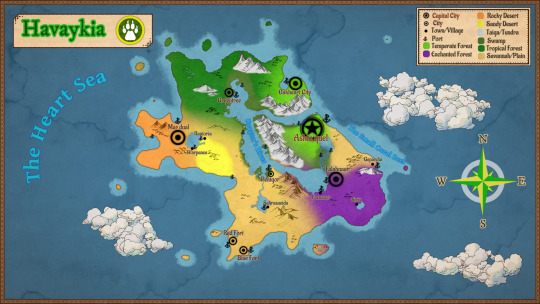
Cities, Towns and Villages:
Ashte'quel - the capital and largest city of Havaykia, where all races and factions coexist peacefully.
Falahnaar - the city of Kaldorei, which is quite similar to the now destroyed city of Darnassus from Azeroth. The Night Elves tend the wilderness and a gigantic tree called Kaldrassil.
Oakheart City - the city of former Alliance's fighters. It is the oldest city of Havaykia, where the first inhabitants settled. It is named after the occurrence of oak forests with heart-shaped leaves.
Greentree - the harbor city, where the best fishermen of the island live.
Mardual - the city of former Horde's warriors who see war as a dishonest and pointless fight for territories that do not belong to them.
Warpeace - the oldest city from the Horde's side. The city got its name from a small civil war due to food shortages, which luckily ended without fatal consequences.
Raptoria - the village of trolls, which is known for important breeding of several genuses and species of raptors.
Peatgor - the city covered with peat. It is known to archive the historical writings of Havaykia.
Red and Blue Forts - the both cities of former mercenaries from both teams. Even though they are no longer fighting each other, there is still tension and discrimination between them.
Sahrasaeida - the village near an oasis and a popular resting place for travelers.
Faenanor - the school village of druids, where newcomers learn new skills of druidism.
Strix - the Kaldorei's village, known for its important breeding of birds of prey and owls.
Gepardia - the village later becoming a town. Residents do projects to protect the cheetahs, but other endangered species and the environment on the island.
Cheetah's Valley:
Cheetah's Valley is mainly a savanna area known for the highest population of cheetahs. This is the most peaceful and safest place on the island, but it's not always like that. The climate is mostly mild and the savannah part of the valley experiences high temperatures in summer and snow in winter at higher elevations.

Points of Interest:
Entrance into the Valley - The only land entrance to the valley, as Pecker's Hills and Falcon's Highlands are often dangerous to pass through. Herds of animals often pass through it.
TaE Family's Ranch - Home of the TaE Family, which is not just like a family, but also like a small community that is outsided by society. They raise domesticated hadrosaurs and small feathered theropods, but also help injured and abandoned animals. Since there is nothing there that would attract the other factions, the Templars still plan to take over their ranch and could use it to create a new position for Abstergo. Of course the TaE Family fights back and for this they later form an alliance with the Assassins to save their home.
Assassin's Hideout - The new home of the Assassin's Brotherhood since the destruction of the Accipiteria. They settled in Falcon's Highlands to keep the Templars from getting to them and started training new novices. Assassins travel all over the island on missions to make the island a better place with more freedom.
Palins Farm - A farm owned by the Palins Family, who are family friends of the TaE Family and trade supplies with each other. The Palins Family work honestly and as a result they usually have the best vegetables and fruits grown in the valley.
Survivor's Saferoom - A shelter located not far from Gepardia where the survivors live. They keep their distance from others as they have had interactions with the Infected and can be carriers until they find out the vaccine exists. Still, they decided to hunt down the Infected so as not to endanger the innocent.
Cheetah Sanctuary - Rescue center for cheetahs and other animals and educate the public about fauna, ecosystem and environment.
RED & BLU Camps - The camps of both teams, where the mercenaries came to find available materials for production, which is illegal in Havaykia.
Infected's Refuge - A hidden place within the borders of Pecker's Hills, where the Infected and mutants hide from the civilization that wants to eliminate them.
TaE Family's Ranch:

Ranch Entrance - A stone arch welcomes visitors.
TaE Family's House - A large house where 25 people can live there.
Workshop - There they are created and repaired as fences, furniture and wooden decorations.
Warehouse - Food grown there is supplied.
Food Garden - Fruits and vegetables are grown, which are in charge of Elphina, Tarion and Relante.
Hadrosaur's Barn - A stable where hadrosaurs such as Parasaurolophus, Lambeosaurus, Olorotitan, Corythosaurus and Tsintaosaurus are housed, but also smaller dinosaurs such as Dryosaurus and Leaellynasaura. There are incubators for eggs dropped by females and stall boxes for babies.
Hadrosaur's Enclosure - Herbivorous dinosaurs graze and live like in the wild. On the left side of the enclosure, there are three lookouts through which you can safely observe the dinosaurs.
Lily Lake - Water source for enclosure residents and fun fishing.
Mini Raptor's Enclosures - Two aviaries where Microraptors and Archeopteryxes are kept.
Cerato's Enclosure - The enclosure of TaE Family's tamed Ceratosaurus named Cerato (I'll probably change the name later because it's a bland name for Ceratosaurus), which was raised by Clara.
Veterinary Building - Injured and sick animals are treated here.
Recovering Enclosure - An enclosure for treated animals to recover, so that they can later return to nature.
#so... I apologize for saying yesterday it will take a long time bcs I thought I would lose motivation shortly but luckily it stayed#it's not perfect but I'm glad that at least I wrote something#tamiisnthere's artwork#tamiisnthere's fanfic#Crossover Universe
19 notes
·
View notes
Text
Special Delivery! Here Are 17 Curious Facts About The Cincinnati Post Office
On The Barrelhead
The Cincinnati Post Office was established in 1794 and received soon after its first mail delivery, consisting of sixteen letters, two newspapers and a snuff box. All mail then was “collect on delivery” or COD – recipients paid the postage. Postage for a simple letter was 25 cents. The postmaster displayed all mail on top of a barrel at his house. Anyone wanting to collect mail paid the postmaster.
Returned To Sender
Cincinnati’s first postmaster was an attorney and Revolutionary War veteran named Abner Dunn, who ran the local post office out of his house at the corner of Second and Butler streets. Postmaster Dunn died in 1795 after only a year in office and was buried in the backyard of his house, which was also the backyard of the post office. The site is now a parking lot near Sawyer Point Park.

Everybody Knew Your Business
From 1799 up until Cincinnati adopted free home delivery in the late 1860s, the Post Office regularly published a list of all letters awaiting collection, so everybody in town knew when you had mail. If you ignored the published list for three months, your mail was sent to the dead letter office. The lists were extensive, occupying, in small type, as much as half a page in the Cincinnati Commercial or Gazette.
Keep It Under Your Hat
Cincinnati’s fifth postmaster was an eccentric Methodist minister named William Burke, who served a very long term from 1814 to 1841. Possessed of a deep, guttural voice attributed to his lifelong addiction to chewing tobacco, Burke is remembered for personally delivering mail around town while making social calls. He kept the items to be delivered in his hat. It is said that “Father Burke,” as he was known, also delivered wise counsel to his patrons along with the mail.
Penny For Your Thoughts
During the 1840s, Cincinnati experimented with home delivery, but charged for the service. Two “penny postmen” divided the downtown area, with Joseph Haskell taking the route north of Fourth Street, and Hiram Frazer delivering south of Fourth. Recipients, in addition to the standard postage, coughed up a penny for each letter delivered to their front door.
Inaugural Air Mail?
The first mail at least partially delivered by air left Cincinnati on Independence Day 1835. Obviously, no airplane was involved. The pilot was the “Prince of Aeronauts,” Richard Clayton, and the vehicle was his renowned balloon, the Star of the West. Clayton ascended from an amphitheater constructed in the middle of Court Street between Race and Elm with, among other cargo, a satchel of mail intended for eastern cities. He crashed 100 miles away in Pike County and had the post office in Waverly, Ohio, send the letters the rest of the way. A trial involving an airplane in 1912 was really a gimmick in which mailbags picked up at Coney Island were dropped at the California Post Office, just 8,000 feet away.

What The Dickens?
By 1825, stagecoaches had replaced pack horses as the primary vehicle for transporting mail throughout the Ohio Valley and nascent Midwest. In addition to letters and newspapers, mail coaches carried passengers and were often the most reliable means of travel available outside the East Coast. When Charles Dickens visited Cincinnati in 1842, he arrived by mail coach.
Postmaster Is The ‘Last Man’
On 6 October 1855, Cincinnati Postmaster John L. Vattier sat down to a most unusual dinner. His table was set for seven, but every place setting, excepting one, was empty. Vattier was the last of seven young Cincinnatian men who survived the 1832 cholera epidemic, bought a pricey bottle of wine, and pledged to meet each year for dinner, saving the bottle for the last of them to survive. On that evening, following the funeral of his last colleague, Vattier dined alone and drank the bottle in memory of his friends.
Postal Currency – What A Riot!
As the United States struggled to finance the Civil War, an unintended consequence was a shortage of coins. The Post Office stepped up to alleviate the shortage by issuing postal currency in the form of “shinplaster” paper bills in fractions of a dollar. Public demand was so great in Cincinnati that a riot broke out at the distribution center on 5 November 1862. Although no one was seriously injured, federal troops called in to disburse the 2,000 rioters drew swords and attached bayonets to their rifles until calm was restored.
Shillito Becomes A Worthy Investment
Cincinnati merchants, notably John Shillito of department store fame, devised creative ways to issue change when coins were scarce. During the coin-scarce Civil War, Shillito noted that his customers often used postage stamps as currency. Shillito crafted special circular cases to contain one-cent, three-cent or five-cent stamps and used them just like coins in providing change to customers. Today, an 1862 Shillito “encased postage” coin can bring as much as $1,250 at auction.
Hier wird Deutsch gesprochen
You didn’t have to be German to manage the Cincinnati Post Office, but it didn’t hurt. Between the Civil War and the Twentieth Century, Cincinnati had 10 postmasters and fully half of them were born in Germany. Our Teutonic mail mavens were John C. Baum (1861 to 1864), Frederic John Mayer (1864 to 1866), Gustav Robert Wahle (1874 to 1878), John P. Loge (1878 to 1882) and John Zumstein (1891 to 1895).
Wayward Mail
According to the Post [9 July 1891], Cincinnatians were lucky to receive any letters at all because of their incompetence at addressing envelopes. The Cincinnati Post Office reported that year 156,275 incorrectly addressed letters, 15,620 insufficiently addressed letters, 2,632 illegibly addressed letters, and 10,923 incorrectly stamped letters. In all, 279,385 pieces of wayward mail were returned to sender by exasperated Cincinnati postal clerks. The staff specifically assigned to decipher bad addresses were called “Nixie” clerks.
Babies By Mail
The United States Post Office introduced parcel-post deliveries in 1913 and boasted that anything – anything at all – under 11 pounds was suitable for shipment. Taking the Post Office at its word, a Clermont County farming couple, Jesse and Matilda Beagle, made history on 25 January 1913 when they packed up their infant son, and shipped him off via parcel post to his grandparent’s house. The Associated Press claimed the Beagles were the first customers to utilize the new parcel post system in this manner.
Potatoes, Too!
A Kentucky farmer did the math and determined that parcel post rates were cheaper than hiring a dray to get his potato crop to market. On 28 October 1916, the Cincinnati Post Office found 35 sacks of spuds, weighing 50 pounds each, waiting to be processed and delivered to a Court Street wholesaler. All 1,750 pounds of taters arrived at their appointed destination by mid-afternoon.
Photographic Memory
Postal employees were legendary for their ability to accurately deliver mail bearing a minimal address. That skill was tested to an extreme in 1929 when an envelope arrived in Cincinnati bearing only a photograph of a building and the name of the city. A postal clerk recognized the building in the photograph. Sure enough, the letter was intended for Oliver F. Slimp, manager of the Edwards Building at 528 Walnut Street, the building pictured in the photograph pasted on the envelope.
The Porn Stops Here
Federal investigators tracing the distribution of obscene materials throughout the Midwest found that most of the pornography was mailed from Cincinnati. On 28 November 1940, postal inspectors struck paydirt in a West Eighth Street warehouse, where they found 28 rolls of motion picture film, 2,000 photographs, 3,000 printed cartoons, a dozen cartons of obscene literature and related printing plates. Two Cincinnati men were arrested as a result of the raid.
End Of The Line
Cincinnati’s art-deco styled Main Post Office on Dalton Street was originally constructed in 1933 as the Dalton Annex. The huge building was intentionally located adjacent to railroad lines and the new Union Terminal because so much mail was transported to Cincinnati by train. That advantage disappeared on 17 November 1974 when the iconic track-side facility received the last shipment of mail to arrive in Cincinnati by railroad.

7 notes
·
View notes
Text



Things are becoming so strange, so surreal, so nihilistic in contemporary America that the chaos can only be deliberate. Chance, incompetence, and accident could not alone explain the series of disasters we now daily witness that are nearly destroying the country.
When the ailing and non-compos-mentis president now speaks, he rarely becomes excited about Iranian or terrorist provocations. Biden seems restrained even at Russia’s outlawry in Ukraine. The atrocities of Hamas now earn only measured objections from Biden. He does not seem too angered by the collapse of the border. Nor do the deaths of 100,000 Americans to imported fentanyl earn a loud trademark Biden scream.
No, what earns his unchecked ire, often expressed in shouts and hysterical tones, are Donald Trump and his supporters. Most recently, out of nowhere, Biden resurrected the old and proven falsehood that Trump had libeled the Normandy dead as losers and suckers. He then compounded that libel by claiming Trump’s supposed dismissal of the heroic dead was a grievous family insult to his own late son, who did not die either in combat or while in uniform but in 2015, tragically, from brain cancer.
During these anti-Trump fits, Biden wakes up and his face tightens up. He begins screaming, in uncharacteristic, animated fashion, anytime he can smear half the nation’s voters as “semi-fascists” and “ultra-MAGA” extremists. In private, he swears that Trump is a “f—ing asshole” and “sick f—k.” If only Biden substituted “cartel” or “Iran” or “Hamas” for “Trump” or “MAGA.” we might see an animate president.
A Borderless Nation
Meanwhile, a mob of illegal aliens recently tried to kick and stomp sprawled New York peace officers into senselessness—felonies that would earn any such violent citizen a decade or more on Rikers Island.
Yet somehow, only a few were arrested. Stranger still, all of them were immediately let go without bail—as if freeing wolves to prey further upon sheep.
Upon release, a few smirked and flipped their middle fingers to bystanders. Apparently, they wished to show Americans that they are violent, crude, unrepentant, and exempt. And thus they tell us that their newfound hosts are fools for letting the likes of themselves in.
And why not, given the attackers bussed with impunity to California—the land of free everything if only one qualifies as illegally residing in the U.S.
These grotesque bullies are part of the eight-million illegal aliens who pranced across the southern border without background checks—all taking Biden up on his 2019 encouragement to “surge” the border with impunity.
Many brandish their cartel affiliations. Some pay for their transit by smuggling cartel fentanyl, which contributes to 100,000 American overdose deaths per year. Others sport lengthy criminal records. All seemed to have been welcomed out of their countries by conniving Latin American governments and mysteriously invited into our country by our derelict president.
The Death of the Law
There is a continuing pattern here. Sometime around late 2020, Americans woke up in a country they no longer recognized. That summer, tens of thousands of rioters had looted, burned, killed, maimed, and assaulted for four months with veritable impunity. Leftwing mayors and governors dubbed the violence as “largely peaceful” demonstrations or a “summer of love.”
The 2020 legacy of defunding the police and exempting criminals on the basis of their race or ideology is that each week now videos circulate of massive looting, smash-and-grab epidemics, and deadly car-jackings in our major cities. No one cares much about the small business owners who are ruined.
Who laments for the poor who lose their last shopping outlet? Does the Biden administration worry over the terrified employees who are ordered to stand back or the occasional security officer totem instructed to stand down?
Instead, we are to empathize with the thief, the assaulter, the rapist, and the carjacker—at least in the sense that he does not deserve punishment for the mayhem he caused, given we, not he, are supposedly the true guilty parties. A lot of innocent and defenseless people have been assaulted and killed since 2020 as the wage of that toxic theory.
So the subtext of all these violent acts is exemption based on perceived correct race, ideology, or membership in the supposed victim/oppressed binary. The perpetrators are either not arrested, let out the same day as arrested, never charged, or never convicted. And the result is a growing distrust of the law and a cynicism that there is little law anymore, just statutes used against political undesirables.
If, for just one month, the Biden justice department used the same resources and budget it has spent the last three years rounding up bystanders at the January 6 riot and instead prosecuted, convicted, and jailed these big-city violent assailants, then the crime epidemic could be solved.
The Implosion of the University
As a general rule, in 2024, the more “prestigious” our universities, and the more they prided themselves as elite or Ivy-League, the more likely there were racially segregated dorms and graduations, a virtual anti-Semitic hounding of Jewish students, grade inflation, watered-down courses, and pro-Hamas terrorist demonstrations.
For nearly a hundred years, universities told us that the SAT or ACT admittance exam was critical in determining their admissions. It was sold as a way to confirm the potential and preparation necessary to perform at a level demanded by these elite schools. The tests were praised as a meritocratic tool to determine talent by honing grade point averages and allowing opportunity to those without money and contacts. Then suddenly, in 2021, these tests were mostly junked.
That dismissal of standardized tests was a de facto admission that:
1) Universities had been admittedly wrong for a century that standardized admissions tests had any value in determining the degree of student preparation needed to complete a rigorous Ivy League class load.
or 2) in the interest of diversity, equity, and inclusion, the university would now be free to admit students who could not meet their prior unrealistic or unnecessary standards and instead would accommodate new students by suddenly inflating grades, introducing easier classes, or diminishing required course work.
Of course, the university admits to neither of these realities. It compounds the deception and fraud by claiming new generations of students are more competitive and gifted than ever and will leave with degrees that guarantee employers rigorously trained graduates. Time will soon tell.
The End of Deterrence
The same nihilism characterizes our foreign policy.
Our worst enemies could not have planned a more disastrous and humiliating withdrawal from Afghanistan than the Biden administration’s August 2021 scamper. We simply, without an afterthought, abandoned billions of dollars of sophisticated weapons to Taliban terrorists.
We left behind a $1 billion new embassy and a remodeled Air Force base. We bragged about taking out terrorists with a “righteous strike” that wiped out an entire friendly Afghan family, while 13 American service personnel were blown up trying to secure a non-securable escape route.
Then followed the mysterious laxity as a Chinese spy balloon lazily traversed the U.S. with impunity. Next was the radical drop-off in military recruitment. If one wished to ensure that the one group that serves—and dies—in combat units at twice its demographics would exit the military en masse, prompting an enlistment crisis, the Pentagon could not have done a better job.
The top brass all but accused its white male recruits of being prone to toxic white supremacy, only to form a task force to root it out—and then discover such rage and hatred never existed in the first place.
It nonetheless drummed out 8,400 veterans for not receiving the mRNA vaccinations, many of whom had naturally acquired immunity and real doubts about the efficacy or safety of the inoculations. And, finally, the Pentagon made it known that prior standards of recruitment, promotion, and evaluation had apparently weakened the military. Therefore, new race- and gender-based criteria would ensure fewer and now unneeded white males in positions of rank and influence.
Abroad, China serially threatens to annex Taiwan. A hungry and perennially restless Vladimir Putin once upon a time thought he was restrained from invading his neighbors by fear of more costs incurred than the likelihood of benefits to be gained. But like an earlier reaction to a weakened U.S. in 2008 and 2014, Putin assumed that the 2022 Biden administration would likely do little if he annexed greater swaths of Ukraine. And so he invaded.
National security advisor Jack Sullivan, on the eve of the October 7 Hamas massacres of Jewish citizens, claimed the Middle East was at last calm. Now it is on the verge of a theater-wide war, once Iran sensed that the Biden team would appease and beg it to behave.
So the Biden administration was eager to end oil sanctions, plead with Iran to reenter the Iran Deal, remove the Houthis from terrorist designations, route billions of dollars to Tehran for hostages, junk the Abrams accords, and restore millions of dollars in please-be-nice bribe money to the Palestinians.
Biden’s abject misreading of human nature has ensured that a thuggish theocracy that slaughters abroad and tortures at home would interpret that reproachment as either naiveté or stupidity. And thus it would respond with contempt and escalating aggression. And so it has.
Somehow, over just three years, the Biden administration did to the Middle East what it did to the southern border: blew it up in the same exact manner of mindlessly undoing any policy that had previously worked with Trump’s finger prints on them.
What Is Going On?
What is the common denominator, what is the rationale behind the anarchy, and what is the reason why a president would so willingly rend the fabric of America?
Why would the government privilege the illegal alien over the law-abiding citizen? The violent pro-Hamas, anti-Semitic foreign-born protestor over the peaceful pro-Israel, U.S. citizen? The smash-and-grabber over the dutiful security guard?
We are nearing a French Revolution, reign-of-terror moment. The law seems to be what a cabal of hardcore leftists who control the Oval Office say it is.
Joe Biden’s administration offers no better confirmation of warnings from Thucydides to Thomas Hobbes that the veneer of civilization is precious, hard-won, quite thin, and beneath it churns innate human savagery and chaos roaring to be released.
So why did Biden unleash the hounds of anti-civilization? Did he despise the supposedly boring middle-class citizen who follows the law, pays all his taxes, and never gets arrested? Does he hate the idea of meritocracy? In Biden’s puppeteers’ dangerous calculus, is all this savagery and chaos a deliberate mechanism to ensure parity? Equity? Inclusion?
So is the deliberate nihilism—economic, social, cultural, social, and political—a way of leveling the field? Making life difficult for the more successful? Making those who cherish the traditions and protocols of America pay?
Is that the plan to take the country to near collapse, and then only at the abyss itself to force revolutionary change—or else?
How else can anyone explain the descent of our city downtowns into dank medieval cesspits, our notion of male and female transformed into the sexual circus right out of Petronius’s Satyricon, our race relations into a mixture of Rwanda and Yugoslavia, and our universities into Soviet-like “People’s Universities of Correct Thought?”
None of this was by accident. It is the dividend of a philosophy that says, “We have to blow up your America before we can reboot it for us.”
3 notes
·
View notes
Text
Isle of Dogs (2018)

Isle of Dogs is such a unique film it’s hard to categorize it. There’s comedy but the story isn’t afraid to be emotional. It’s animated… but not made for kids. The dialogue is partially in English, the rest is in Japanese and there are no subtitles. There’s nothing else like it out there, which makes it fascinating from beginning to end.
In Japan, 2038, Megasaki City's Mayor Kobayashi (voiced by Kunichi Nomura) uses a sudden dog-flu epidemic as an excuse to banish all the city's dogs to Trash Island. Six months later, his adopted nephew, Atari (voiced by Koyu Rankin), travels to the island to rescue his beloved pet, Spot. With the help of a pack of dogs - Chief (Bryan Cranston), Rex (Edward Norton), King (Bob Balaban), Duke (Jeff Goldblum), and Boss (Billy Murray) - he navigates the perilous terrain. Meanwhile, dog-lovers on the mainland try to find a cure for the dog-flu.
The visuals strike you immediately. Rather than try and have silky-smooth stop-motion animation, director Wes Anderson shows us the animator's "finger prints" on all of the dogs. You can tell by each animal's fur where the models have been manipulated for each shot. The color palette is gorgeous, even when you’re looking at mounds of trash. Every frame is worthy of being hung up on your wall. The backgrounds are so full of detail you could look at them for hours, admiring the composition, framing, and different hues used to emphasize the mood of each scene. Smoke is created with little white tuffs, TV screens cut to traditional 2D animation, we see traditional Japanese-style paintings - there's always something new.
The story’s absurdity perfectly matches the deadpan humour. All five dogs in the pack accompanying Atari are alphas - you can tell because their names are all synonymous with “leader". This means they have to vote on every decision. It’s ridiculous in the best way. The uniquely comedic tone means you never know what's next. You think we’re headed into a dramatic moment, that this character is dead - that’s a shock but it fits in the movie - but then the movie will point out that there’s NO WAY things would go that way and reveals the scene you just saw as a fantasy. You’re so taken aback it might take you a second to laugh but you’ll be in stitches.
It’s a bold film that experiments and innovates at each opportunity… except for one. As mentioned earlier, the film is set in Japan but most of the dialogue is in English to show that dogs and people can kind of understand each other a little bit but ultimately speak different languages. The dogs in this movie don’t actually speak English but for the audience’s purpose, they do. There are also other characters which speak English - real English. They often say things to help us fill in the details. It isn’t clunky exposition but it does make you wish the film was not in two but THREE languages. Two for the humans and one for the canines so there would be a true separation between the species. Is that worth docking points for? I don't think so.
Isle of Dogs does things that in any other movie would be called sloppy. In one scene, Mayor Kobayashi leaves a critical piece of information lying around. Someone he doesn't want seeing it finds the information. The fact that it’s there makes no sense but the character who discovers this info does nothing with it. Ultimately, it's unnecessary to that particular storyline but for the film as a whole, it's important. It fills the viewers in on something that’s coming later. Rather than be stuck on the surprise when it arrives, you sit back and have a laugh at the characters’ reactions. It’s so unconventional it's perfect and could only work in a film like this one.
Like most of Wes Anderson's other projects, Isle of Dogs is so off-beat it will leave some viewers behind. Let it sit with you for a while. Better yet, watch it along with other Wes Anderson movies. Let yourself fall into the groove. You'll see. Isle of Dogs gets better with each rewatch. (August 21, 2020)

#Isle of Dogs#movies#films#movie reviews#film reviews#animated movies#animated films#wes anderson#roman coppola#jason Schwartzman#kunichi nomura#bryan cranston#koyu rankin#edward norton#liev schreiber#bill murray#bob balaban#jeff goldblum#scarlett johansson#tilda swinton#2018 movies#2018 films
8 notes
·
View notes
Text
Tilin has three dad's
a/n: This is a little blurb I had in mind, hope you enjoy ♥. It was made because Q doesn't know who is Tilin other dad so, now I'm making his two possible fathers meet
Okay but imagine when Wilbur comes back to the server and Tilin goes to greet him, WIlbur confused bc, there are literally an epidemic of egg kids in the island, everyone he comes across is being follow or following an egg, even Philza, who presented him Missa (some distant cousin of Kristin) and their "son" Chayanne.
Suddenly he felt something kick him, and when he looked down there was a small egg, who Missa called Tilín, the kid looked at him very intensely.
"Tilin, where is your dad?" Philza asked and the little egg, but the egg was just facing Wil's direction and he was getting a little uncomfortable with the intense 'glare' "Oh! This is Wilbur, he... oh backflipo?" Tilin started to do backflips and jump around and ran to a direction, stopped and look to the little group he left behind, Wilbur was kinda weirded out but the 'couple' understood him
"Wilbur" Missa spoke to the man "Tilin is waiting for you, follow them" brown doe eyes looked at Missa, who was kindly smiling while Philza was about to cackle. With no other choice, the tall man followed him until they reached a house, where two silhouettes were seen through the window. Tilin opened the door (somehow) and left it open, Wil was going up the stairs while Quackity was scolding Tilin and going to close the door, once he reached the door he saw the man he was sure was dead at this point. Wilbur was wearing his yellow sweater and a small breeze made his hair move making him looke ethereal.
Quackity was shocked, he freezed holding the doorknob, when the brithish was about to say something another voice coming from inside the house stopped him "Hey Quacks, where is the sugar?"
Luzu was wearing an apron with Tilin hiding behind his leg, clearly baking something, Wilbur was surprised with the scene in front of him, he connected the dots and came with the conclusion, Luzu is little Tilin father, and with that conclusion the colors reached his face, he was just about to apologized when the man spoke
"Hey! You are WIlbur, right? Wanna join our dinner?"
Quackity wasn't even able to utter a word, his brain was just a red button being pressed, Mis dos viejas en la misma casa (My two lovers in the same house), part of him was hoping that Wilbur would say no, but the man surprised him with a shy yes and little Tilin ushering him into the house. Why would the Gods hate him so much for this to happen to him?.
15 notes
·
View notes
Text

SUMMARY: On an island off the coast of North America, local residents simultaneously fight a zombie epidemic while hoping for a cure to return their un-dead relatives back to their human state.
mod Z has no interest in seeing this movie after hearing it’s not as good as the others.
#survival of the dead (2009)#zombie#disease horror#2000s#united states#north american movie#horror#poll#movies#more than 50% havent heard
5 notes
·
View notes
Note
hat is your avatar?
Oh! My avatar is the player character from Dead Cells, the Beheaded.

Specifically taken from the Fatal Falls DLC trailer, it's him hanging out with one of the game's optional pets, the Biter. (if you follow the link, warning for blood and relatively toony violence. also the biter does die very early on, but nothing is shown besides the ribbon)
Dead Cells is a game I am quite fond of, so in the off chance you are unaware: it's a roguelike game where you play a headless, immortal prisoner stuck in a time loop during a zombie plague. It has a breadcrumbs approach to lore and storytelling where most of what you find is through optional lore rooms, and is, at least in my opinion, a visually gorgeous game that uses a blend of pixel art and rotoscoping.

The game maintains a tone with a lot of gallows humor, but it manages to do so without a real sense of heartlessness. That said, it is a very bleak world featuring a lot of frank depictions of prison brutality, the aftermaths of executions, an unjust social system, a rather unpleasant epidemic, and basically total collapse of the island's population. The relative lightheartedness shown in the animated trailers is there, but a lot of it is that you are playing a character who has witnessed and experienced enough death that he's mostly burnt out to the horror of it.
Most of the love I feel for the game is in its mechanics- it has a swift-paced and very rewarding combat system that encourages you to get clever with your loadout. It IS a game that prides itself on being "tough but fair", and most notably, one of the recent free updates from the game involved a huge package of different accessibility settings including the ability to manipulate the UI to a great degree, change the contrast on the foreground vs. background, outline characters, switch to a dyslexia-friendly font, add more forgiving windows on parries, auto-hit functions, and the option to get knocked back to the start of the level instead of all the way back to the beginning, and none of these options disable achievements.
There's a lot of love put into its construction and as someone who does not have that much experience with roguelikes, I've logged 245 hours of gameplay on it as of this post.
If you're interested, I'd recommend checking out the animated trailers, as IMO they do a very good job of indicating the overall tone and spirit of the game. The one thing that gets done in the trailer that you can't do ingame is the pan-chucks from The Bad Seed, and they are actively adding those in the next update.
#Dead Cells#there is so much I could say about this game#but [wiggles fingers] ooooo you wanna play Dead Cells#the paid DLC are like five bucks a pop also#whole game is VERY affordable and they have a huge number of free updates to only four dlcs and you can play the game without any of them#not only is there a real frying pan weapon it is actually really good
47 notes
·
View notes
Text
Fragments of fright (6)
From Edouard Brasey's "The Great Encyclopedia of the Marvelous"
Some Greek undeads
Vrukolak
[Note by OP: The name of the creature is a bizarre subject... You see, the original Greek term for them is "vrykolakas" or "vrukolakas" - which is why I take the English form "vrukolak", even though they are also sometimes known in the English world as "vukodlak". Note however that, in France for example, the term became "Broucolaques" - which is also found in other European countries. Take for example The Witcher who uses the Polish version that in English becomes "brukolak".]
The vrukolaks are found in Greek islands - most notably on Santorini in the Egean Sea. A vrukolak is a person who died in a "state of sin" (not confessed, not receiving the last Christian rites, having committed crimes for which they they were not purified), but also a person who wasn't properly honored during their funerals, or a person who died with a debt to pay, a revenge to perform or a question of honor to settle. These undeads do not rot like a regular corpse - rather, their still living and un-rotting bodies haunt the living and drink their blood like vampires. However, unlike vampires which are octurnal creatures, vrukolaks act as much during the day as during the night. The vrukolak will keep terrorizing the living until either their "mission" is accomplished, or until they obtained reparation for whatever offense they received.
Collin de Plancy wrote about the "broucolaques" that they were Greek vampires, most of them being the "spectres" of excommunicate people - unable to rot in their graves, these wraiths appeared during the day as during the night, and it was a very dangerous thing to meet one. Léon Allatius, in the sixteenth century, wrote even more about these creatures. He explained that in the island of Chio, the inhabitants only anser to their name being called if it is called twice - because the vrukolak are only able to call someone's name once, and cannot repeat it a second time. The inhabitants also believe that if a vrukolak calls the name of a living person, and if this person answers, the wraith will disappear - but in return the person who answered the call will die in a few days. It is something that was common with the vampies of Bohemia and Moravia. Collin de Plancy added that, to prevent the vrukolaks, the Greeks unburied the ghost of the assumed wraith and burned it after reciting some prayers. Once the body was turned to ashes, the vrukolak stopped appearing. Another way to get rid of a vrukolak as to exile them to a small, deserted island - like all demons, vrukolaks cannot stand salt and so they are unable to cross the sea.
Sometimes, however, the vrukolak do not return to terrorize the living - they can return because of some debt of honor. In this case, no frontier, no limit and no obstacle can stop them from preventing their mission - they can cross the sea as they crossed the world of the dead back to the living. A famous story from the Sporades islands tells of a young girl name Arete, who lived with her mother and nine brothers. A wealthy Persian merchant who was passing by wanted to make her his wife - but the girl's mother refused to let her daughter leave her household despite the potential husband being a very good suitor. Her younger son, Constantin, then solemny promised her, if there was such a need, to go fetch himself his sister and bring her back home, wherever she was - and it was thanks to this vow that Arete's mother allowed her to leave with her husband. Years passed, and Arete never sent any news of her situation back home. Her mother hadn't forgotten her, and regretted sending her away. Even worse - a deadly epidemic stuck the island, and the nine brothers of Arete died. Their mother doubly cried - she hadn't just lost her sons, but also her daughter since Constantin now could never bring her back. However, enraged, she went to the cemetery and before Constantin's tumb she said "Constantin, I remind you of your word. Go seek your sister, and brng her back. May you never rest in your grave until you made well of your promise!" She then went back to her home, and stayed in bed for three days.
The fourth evening, a violent wind blew over the island. The door of the house opened itself brutally and Constantin appeared there, half-rotten, his clothes in tatters. He held in his arms his asleep sister - he had turned into a vrukolak, and had gone to Persia to bring her back. Afraid, the mother tried to banish the ghost, and did so by throwing a handful of salt in a jar of water saying "My son, may your curse dissolve like this salt in water. Rest n peace now." Immediately, the vrukolak left home and returned to his grave, while the mother died in the arms of her daughter.
Kallikantzaros
Also called Karakonzule, Karkantzari (Macedonia), karkansoli, kakanxholi (Albania), karakondzi (Bulgaria), karakondzuli (Serbia), karanjoloz (Croatia) and carcazol (Armenia)
The kallikantzaros (in plural, kallikantzari) is an undead that drinks the blood of humans and beasts. It is found all over the Balkans, but is most prominent and dominant in Greece. Three types of people become kallikantzari after their death: children died without being baptized, foreigners dying on local ground, or the people born between Christmas and the Epiphany. The kallikantzari appear in the shape of hairy man, with goat feet and goat ears (making them similar to the satyrs of Greek mythology). Just like these ancient beings, the kallikantzari are said to greatly love dancing, and enjoying the pleasures of the flesh with women. But a kallikantzaros can also take animal shape - turning into a horse, a dog, or a wolf. In the latter case, they are called likokantzari, a Balkanic variation of the "werewolf". The kallikantzari have a leader - the Koutsodaimonas (Kutsodaimonas), who is identical to a kallikantzaros except for the fact that he has horns, and looks wilder, savager, more demonic than the others. The koutsodaimonas protects the kallikantzari from any attacks against them, and encourages them to perform evil deeds. The only way to repel or banish this entity is by brandishing before him a burning "Christmas torch".
In the island of Lesbos, the kallikantzari are rather human-looking imps or dwarfs, with hooked nails, and pointy caps. They enter human houses between Christmas and the Epiphany - during thosefifteen days, they turn the house-upside down, break everything, make all sorts of noises, steal precious jewels, kill pigs by drinking their blood and eating their entrails - and they also collect the pigs' hair, with which they make their caps. To force these invaders to flee, one must spread ashes alongside every wall, and hang above their doors a pig's head.
3 notes
·
View notes
Text
What is Ossuary
An ossuary is a building or chamber used to store human skeletal remains. The word ossuary comes from the Latin word "os", meaning "bone". Ossuaries are often used in places where burial space is scarce, such as in cities or on small islands.
There are many different types of ossuaries, including:
Crypts: These are underground chambers that are often located beneath churches or cathedrals.
Catacombs: These are underground tunnels that are used to store human remains.
Ossuaries attached to churches: These are small buildings or chapels that are attached to churches and are used to store human remains.
Ossuaries in cemeteries: These are small buildings or chapels that are located in cemeteries and are used to store human remains.
Ossuaries have been used for centuries to store human remains. The earliest ossuaries date back to the Roman Empire. Ossuaries were also used during the Middle Ages, when there was a high death rate due to the Black Death. In the 19th century, ossuaries were used in Europe to store the remains of people who had died in poverty or who had been victims of epidemics.
Today, ossuaries are still used in some parts of the world, such as Europe and South America. In some cases, ossuaries are used as a way to conserve space. In other cases, ossuaries are used as a way to honor the dead.
Here are some of the most famous ossuaries in the world:
The Sedlec Ossuary
This ossuary is located in the Czech Republic. It is famous for its elaborately decorated walls, which are made up of thousands of human bones.
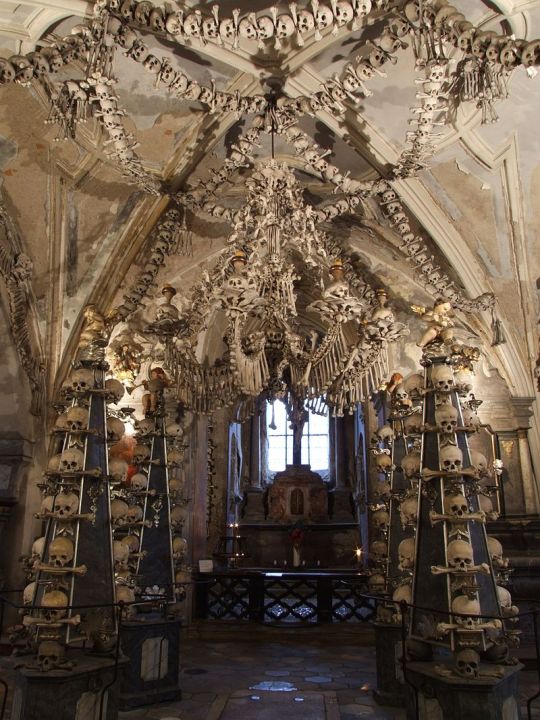
The Catacombs of Paris
These catacombs are located beneath Paris, France. They are home to the remains of millions of people who died in Paris during the 18th and 19th centuries.

The Capuchin Catacombs of Palermo
These catacombs are located in Palermo, Italy. They are home to the remains of over 8,000 Capuchin friars, who were buried there between the 16th and 19th centuries.
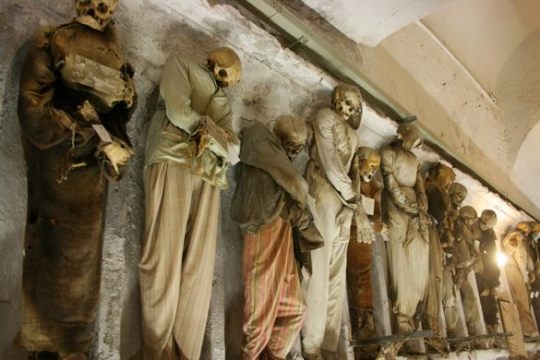
Ossuaries are a fascinating and macabre part of human history. They provide a glimpse into the way that people have dealt with death and dying throughout the centuries.
Follow my YouTube channel. Silent tablets documentary, short videos from ancient history.
Follow my Twitter.
#archaeology#archaeological#archeology#antiquity#ancient history#history#ossuary#capuchin catacombs#palermo#catacombs of paris#paris#sedlec ossuary#czech republic#ancient art#ancient civilizations#civilization
4 notes
·
View notes
Text
Daily Wrap Up June 6, 2022
Under the cut: The bodies of the fighters at the Azovstal steel plant are being turned over to Kyiv by Russia for identification and burial; A Cholera outbreak has begun in Russian-occupied Mariupol due to bodies not being properly cared for or buried; Russia to pay 5m rubles (£65,000 or $80,000) to families of national guards killed in Ukraine or Syria; Heavy fighting continues in the eastern city of Severodonetsk; UN Special Representative on Sexual Violence Pramila Patten said Monday that she believes the humanitarian situation in Ukraine is “turning into a human trafficking crisis.”
“Russia has begun turning over the bodies of Ukrainian fighters killed at the Azovstal steelworks, the fortress-like plant in the destroyed city of Mariupol where their last-ditch stand became a symbol of resistance against Moscow’s invasion.
Dozens of the dead taken from the bombed-out mill’s now Russian-occupied ruins have been transferred to the Ukrainian capital, Kyiv, where DNA testing is underway to identify the remains, according to both a military leader and a spokeswoman for the Azov Regiment.
The Azov Regiment was among the Ukrainian units that defended the steelworks for nearly three months before surrendering in May under relentless Russian attacks from the ground, sea and air.
It was unclear how many bodies might remain at the plant.”-via AP
~
“Russian officials in occupied Mariupol have shut down the southern port city for quarantine over a possible cholera outbreak, according to Ukrainian authorities.
Petro Andryushchenko, an adviser to the mayor of Mariupol, told Ukrainian television that the city is bracing itself for an epidemic as dead bodies and litter are piling up in the city.
Andryushchenko, who left the city early on in the war, cited his sources still in the city, saying, “The word ‘cholera’ is increasingly heard in the city among local officials and their supervisors. As far as we can see the epidemic has more or less begun already.”
He said they were aware of isolated cases in Mariupol, where most of the city’s infrastructure has been destroyed by Russian airstrikes.
The Kyiv Independent reports that Ukraine’s health ministry warned that mass burials and poor access to clean water were creating a risk of cholera in Mariupol.
The ministry began reporting suspected cases of cholera in the region on 1 June, the paper reports.”-via The Guardian
~
“The Ukrainian navy said it has pushed back a fleet of Russian warships more than 100km from its Black Sea coast.
The group of Russian vessels were “forced to change tactics” after carrying out a naval blockade on Ukraine’s coast for weeks, the navy command of Ukraine’s armed forces said on Facebook.
The navy’s update said:
As a result of our active actions on the impact of the enemy’s naval forces, the Russian Black Sea Fleet ship grouping was thrown off Ukrainian shores for more than a hundred kilometres. In an attempt to regain control of the north-western part of the Black Sea, the opponent had to change tactics: deployed Bal and Bastion coastal missile systems in Crimea and in Kherson region; redeploy additional forces to Snake Island.
A group of about 30 Russian ships and submarines continue to block civilian navigation, it said, while the situation in the north-western Black Sea remained “difficult”.
The statement continued:
We have deprived the Russian Black Sea Fleet of complete control over the north-west part of the Black Sea, which has turned into the “grey zone”. Meanwhile, the enemy has adopted our tactics, and is trying to reclaim control of the north-west part of the Black Sea through coastal missile complexes and winged air missiles.
It has not been possible to independently verify this information.”-via The Guardian
~
“The families of Russian national guard members who have died in Ukraine and Syria will receive a one-time payment of 5m rubles (£65,000 or $80,000), according to a Kremlin decree on Monday.
The decree signed by Vladimir Putin said the payments would also go to families of those killed during the “special military operation” in Ukraine’s breakaway regions of Donetsk and Luhansk.”-via The Guardian
~
“Heavy fighting continues in the eastern city of Severodonetsk, with the situation "changing every hour," according to Ukrainian officials.
Oleksandr Striuk, the head of the city's military administration, said "there are enough [Ukrainian] forces and means to recapture the city. There are fierce battles and street fights."
Striuk said Russian forces had a substantial numerical advantage. "They tried to attack the city, and it is happening now. They are throwing away more and more human resources, which of course complicates the situation," the official said.
"Now Severodonetsk is being leveled, because they can't capture it in one to two days. The city is being destroyed. It is impossible to say about the preservation of infrastructure because even before the acute phase of the attack on the city and its assault, the infrastructure was almost destroyed. Both gas and water supply will need almost complete reconstruction," he added.
The highway from the west along which supplies for the Ukrainian front lines travel is under increasing attack from Russian artillery, with Russian units getting closer to it. Striuk said that it "remains under the control of the Armed Forces, but it is still dangerous to move as enemy artillery is reaching [it.]".
The General Staff said that Ukrainian units were thwarting the enemy's attempts to take control of the highway.
The Russians have intensified artillery attacks on areas north of the city of Sloviansk and are shelling Ukrainian positions on the southern side of the Siverskiy Donets river. Russian forces appear to be close to the town of Sviatohirsk on the north side of the river — the site of a historic Russian Orthodox monastery. But there is no evidence that they have been able to cross the river in this area.”-via CNN
~
“Ukraine’s president is asking for a secure corridor for Ukrainian vessels to be able to ship out grain and prevent food shortages in Africa and Asia.
Volodymyr Zelenskyy told a news conference on Monday that Kyiv is in talks with countries like Turkey and the U.K. about security guaranties for Ukrainian ships.
“It is important for us that there is a security corridor ... that the fleet of this or that country ensures the shipping of the grain,” Zelenskyy said.
Zelenskyy adds that “if now we have 22-25 million tons blocked there, in the fall we might have 75 (million tons).”
“What are we going to do? he asked. ”That’s why we can’t do without the ports.”
The issue of blocked grain will be on the agenda on Wednesday during Russian Foreign Minister Sergey Lavrov’s visit to Turkey. Ankara is involved in efforts by the United Nations to reach an agreement for the shipment of Ukrainian grain amid an escalating food crisis.
Zelenskyy says Kyiv hasn’t been invited, possibly because Turkey wants to get security guarantees from Russia for its own ships first.
He explains that Ukraine can’t export large shipments of grain via railways because of long delivery times, even though Kyiv has been in talks with Poland and the Baltic nations. A transport through the territory of Russia’s ally Belarus isn’t an option, he said.”-via AP
~
“UN Special Representative on Sexual Violence Pramila Patten said Monday that she believes the humanitarian situation in Ukraine is “turning into a human trafficking crisis.”
“Women and children fleeing the conflict are being targeted for trafficking and exploitation – in some cases facing further exposure to rape and other risks while seeking refuge,” Patten told the UN Security Council in New York City on Monday.
She said addressing the issue will require “a coherent and coordinated response at the level of European institutions” and “a concerted, integrated and holistic cross-border response humanitarian partners, law enforcement agencies, border forces, immigration officials and political leaders.”
The UN special representative added that she visited reception centers at Ukrainian borders in Poland and Moldova. While there has been an outpouring of financial and moral support for Ukrainians from neighboring countries, there have also been a number of “credible anecdotal accounts from humanitarian staff” regarding suspected attempts of human trafficking, Patten said. She called the protection challenges related to the displacement of Ukrainians “unprecedented.”
“The lack of consistent vetting of accommodation offers and transportation arrangements is a serious concern, as well as the limited capacity of protection services to address the velocity and volume of displacement. There are also concerns regarding the multiplicity of volunteers, with limited vetting, and little or no training or experience,” Patten said.”-via CNN
#Daily Update#Ukraine#Russia#War in Ukraine#Azovstal steel plant#mariupol#Severodonetsk#sieverodonetsk#(same city different spellings)#UN#black sea
32 notes
·
View notes
Note
🕷 Who is your favorite phantom troupe member and why?// 💳 What type of hunter would you be? //🧐 If you were a hunter exam proctor, what type of challenge would you run?//💯 What would motivate you to take the hunter exam? //🐜 If you were turned into a chimera ant, what animal(s) do you think you’d be?//👶 Do you have any hxh OCs?//💭 What is an idea for a fic/drawing you’d like to see?
Once more on mobile and hoping it looks okay lol
Who is your favorite Troupe member and why?
It's a tie between Phinks and Paku, love a blockhead with a heart but also, Paku is my beautiful evil girl boss wife
What type of Hunter would you be?
Monograph/Manuscript Hunter, looking for rare books and scrolls to take back to the library and also helping other Hunters do research
If you were a Hunter Exam proctor, what kind of challenge would you run?
Make contestants research a topic and tell me or write about it, if they explain it well and I think it's cool as hell they get a pass
What would motivate you to take the Hunter Exam?
Money and access to rare things closed off to the public, HxH world gotta have some kind of scary library that's like, a death trap but also full of good resources
If you were turned into a Chimera ant, what animal(s) do you think you would be?
Some kinda weird fox/cat hybrid, I'd still have my glasses tho
Do you have any HxH OCs?
Answered this in the other ask so just gonna do a different character!
Actually, I don't think I've talked about Morel's dad all that much, so a bit about him.
Lysander "Sandy" Markovic possesses both a doctorate in paleography and a Hunter license (it is a miracle he didn't go darkside from the Ph.D.) He caught measles when an epidemic ravaged the town where his family lived and went deaf at age 11, so he communicates primarily through sign language. He met Ursaline Mackernasey when he chartered her to take him to the Green Chantry, an abandoned monastery containing thousands of invaluable tomes and scrolls…smack dab in the middle of an extremely dangerous island. They became good friends over the course of the journey, then friends with benefits, and then Ursaline had Morel. They never married but are basically good friends who happen to have a kid together.
Sandy is a specialist, and his nen ability is Restoration/Destruction Memorandum. He can restore or destroy just about anything with a few nen-infused words scribbled down in a notebook. Cannot bring back the dead nor kill anyone directly with his ability. Created it to restore old manuscripts and hieroglyphs and the like, his services are very in demand and he's published in all sorts of academic journals.
Other facts about Sandy: wears glasses, keeps a full beard because otherwise he looks super young, always has pencils or pens stuck behind his ears, has escaped faculty meetings and/or talking to people via an open window more than once, easily moved to tears (Morel inherited this particular trait), very proud of his son boy always and so glad he can talk shop with his nerdy son-in-law Knov
What is an idea for a fic/drawing you would like to see?
Always down to see more morelknov stuff!!!
2 notes
·
View notes
Text
Ok so today while I was off school I learned about the Mountain Chicken. I was infodumping on the groupchat but most of them completely ignored me. So today, if you choose to read on, you will also learn about the Mountain Chicken. To warn you I’m not a great researcher and some articles weren’t dated so some things may be slightly out of date and some of information slightly conflicts with each other but the story is pretty much the same so it doesn’t much matter
Starting off strong, the Mountain Chicken is not a chicken at all, but a frog. It looks like this;

Pretty cool, right?
Have some cool facts:
It’s other names are: the ‘Giant Ditch Frog’ and the ’Dominican White-Lipped Frog’.
The Latin name is ‘Leptodactylus Fallax’
It is native to Dominica and Montserrat in the Caribbean
They are carnivores and like to eat tarantulas, insects, spiders,snakes, land snails and pretty much whatever else they can find.
They can weigh over 900 grams, reach over 20 cm in length and live for up to 16 years.
It is one of the world’s largest frogs
Their name comes from their call sounding chicken-like and their size. And some people also say that they taste a bit like chicken.
It was also Dominica’s national dish
Using a trilling call. the male entices the female to a nesting burrow. They mate and a foam nest is produced where the female lays her eggs.
She lays infertile eggs for the tadpoles to feed on. When tadpoles metamorphise into juvenile frogs they leave the nest.
The males are very territorial and will wrestle to protect their territory
They have very powerful hind legs that enable them to be able to jump over 2 metres
Also check out this guys grinch feet

But the thing is, they are critically endangered.
There was roughly a 90% population decline after an epidemic of Chytridiomcyosis (Chytrid) in Dominica in 2002 and an epidemic in Montserrat in 2009. Batrochochytrium Dendrobatidis (BD) is a fungus that causes Chytridiomcyosis in amphibians. The arrival of BD to Dominica is what caused the population to decline. Bd is one of the most destructive animal epidemics. It is assumed that the international amphibian trade was a key factor in the spread as infected amphibians may have been transported around the world for consumption and laboratory use. BD was discovered in 98 but by then it had already spread. Within 18 months of the first confirmed case the Mountain Chicken Frog population had shrunk by about 85%. The disease attacks the outer layers of the amphibians skin which affects the ability to regulate water and electrolytes. It also seriously affects tadpoles mouthparts. Some of the symptoms are lethargy, redness of the belly and legs, and muscle tremors. Some amphibians are more resistant so act like vectors, transporting the disease. About 40% of amphibians are at risk of extinction.
After the population decline, there would be loads of dead frogs in streams. Forests used to be filled with the sound of their call but the forest have fallen silent from the loss. Before the epidemic, the population was in the tens of thousands. The disease affecte dover 90 other amphibian species and we could lose another 600 species in 20 years.
In 1997 there was a large volcanic eruption on Montserrat that affected lots of wildlife and their habitats. For instance some bats lost their fur and some fruit-eating bats lost their teeth due to the abrasive action of the ash that covered the fruit. Although the ash was rich in minerals and the forest that survived the explosion began to thrive. The silt from the explosion also almost completely killed the coral reefs but 20 years on the reefs have recovered. The pyroclastic flows and ash destroyed many populations and habitats so the species were restricted to a small place in the island’s Centre Hills Reserve.
However things are looking up due to conservation efforts. The Mountain Chicken Recovery Programme was set up; coordinated by the Durrell Wildlife Conservation Trust,in partnership with the government of Montserrat’s Department of Environment. When the disease hit Montserrat in 2009, 50 Mountain Chicken Frogs were rescued so as to establish a captive population. They established a bio-secure safety net population in 3 zoos across Europe. These have been successful so the frogs have bread many have been microchipped and released back into the wild. An antifungal drug, called Itraconzale, was established and it was used to treat amphibians in the wild in periods of risk. Frogs were washed for 5 minutes in a bag containg the antifungal bath; even if it didn’t actually stop them dying, it showed potential in extending the time till extinction so it was still a success. Over 20 frogs were reintroduced from ex situ breeding programs into a fenced-off area. The area was specifically tailored to the frogs needs with artificially heated ponds to escape the disease as Chrytid can’t survive over 30°C but the frogs can. There is also a live food facility where they breed crickets and cockroaches for the frogs to eat. There used to be one in Dominica too but the captive breeding programme was shut down after Hurricane Maria hit. In Dominica in 2008, the island’s population was assumed dead but in 2011 there were reports of the frog’s call being heard at night.The future is looking good for these guys
Anyway I hope you enjoyed this because I certainly did. I got genuinely quite sad while researching. Sorry if it’s a bit all over the place. I’m writing this from my incoherent messages to the group chat that only acted like they cared when I made a fuss about them not caring. Anyway I feel like I should mention that I did all this after watching a six of crows tiktok.
In case anyone can’t be bothered to read this;
The Mountain Chicken Frog, that resides in Dominica and Montserrat, hit a hard population decline in outbreaks of the fungal disease Chytridiomcyosis. But conservation efforts mean things are looking up for them.
#frogs#mountain chicken frog#endangered#infodump#wth is lizzie doing#if i accidentally mispelled anything no i didnt
5 notes
·
View notes
Photo


Robert Palmer
The Island Records Years 1974-1985 [Box Set]
2023 Edsel
—————————————————
Tracks CD One:
Sneakin’ Sally through the Alley
01. Sailing Shoes
02. Hey Julia
03. Sneakin’ Sally through the Alley
04. Get Outside
05. Blackmail
06. How Much Fun
07. From a Whisper to a Scream
08. Through It All There’s You
09. Sneakin’ Sally through the Alley [single mix]
10. Epidemic
11. Blackmail [alternate take]
12. Get Outside [alternate take]
Tracks CD Two:
Pressure Drop
01. Give Me An Inch
02. Work to Make It Work
03. Back in My Arms
04. River Boat
05. Pressure Drop
06. Here with You Tonight
07. Trouble
08. Fine Time
09. Which of Us Is the Fool
10. Willin’
11. Hope We Never Wake
Tracks CD Three:
Some People Can Do What They Like
01. One Last Look
02. Keep in Touch
03. Man Smart, Woman Smarter
04. Spanish Moon
05. Have Mercy
06. Gotta Get a Grip on You (Part II)
07. What Can You Bring Me
08. Hard Head
09. Off the Bone
10. Some People Can Do What They Like
Tracks CD Four:
Double Fun
01. Every Kinda People
02. Best of Both Worlds
03. Come Over
04. Where Can It Go?
05. Night People
06. Love Can Run Faster
07. You Overwhelm Me
08. You Really Got Me
09. You’re Gonna Get What’s Coming
Tracks CD Five:
Secrets
01. Bad Case of Loving You (Doctor, Doctor)
02. Too Good to Be True
03. Can We Still Be Friends?
04. In Walks Love Again
05. Mean Old World
06. Love Stop
07. Jaelous
08. Under Suspicion
09. Woman You’re Wonderful
10. What’s It Take?
11. Remember to Remember
12. Bad Case of Loving You (Doctor, Doctor) [12” Mix]
Tracks CD Six:
Clues
01. Looking for Clues
02. Sulky GIrl
03. Johnny and Mary
04. What Do You Care
05. I Dream of Wires
06. Woke up Laughing
07. Not a Second Time
08. Found You Now
09. Good Care of You
10. Johnny and Mary [alternate take]
11. What Do You Care [alternate mix]
Tracks CD Seven:
Maybe It’s Live
01. Sneakin’ Sally through the Alley
02. What’s It Take?
03. Best of Both Worlds
04. Every Kinda People
05. Bad Case of Loving You (Doctor, Doctor)
06. Some Guys Have All the Luck
07. Style Kills
08. Si Chatouillieux
09. Maybe It’s You
10. What Do You Care
Tracks CD Eight:
Pride
01. Pride
02. Dead Line
03. Want You More
04. Dance for Me
05. You Are in My System
06. It’s Not Difficult
07. Say You Will
08. You Can Have It (Take My Heart)
09. What You Waiting For
10. The Silver Gun
11. You Are in My System [12” remix]
12. Ain’t It Funky [Si Chatouillieux – extended version]
13. Pride [12” mix]
14. Parade of the Obliterators
15. You Can Have It [12” mix]
16. You Are in My System [instrumental mix]
17. Deadline [12” mix]
Tracks CD Nine:
Riptide
01. Riptide
02. Hyperactive
03. Addiced to Love
04. Trick Bag
05. Get It through Your Heart
06. I Didn’t Mean to Turn You On
07. Flesh Wound
08. Discipline of Love
09. Riptide (Reprise)
10. Discipline of Love [12” mix]
11. Riptide Medley
12. Sweet Lies [12” mix]
13. Let’s Fall in LoveI Didn’t Mean to Turn You On [12” mix]
14. No Not Much [live on the Tube]
15. Trick Bag [live on the Tube]
16. Les Planches
—————————————————
* Long Live Rock Archive
4 notes
·
View notes
Text
Spain’s occupation of Mesoamerica violently disrupted the latter’s evolution, destroying Mesoamerican social institutions, religion, and infrastructure. Within 80 years, 1519–1600, the native population fell from at least 25 million to about a million. What followed was 300 years of colonial rule, accompanied by political and economic exploitation, the categorization of people by color, and the projection of the dominant class’s worldview. It pulled Spain and, ultimately, all of Europe out of the dark ages.
The Spanish Conquest
In 1492, Columbus landed in what are now the islands of the Caribbean. When he could not find sufficient gold and wealth, he turned to trading in slaves.
By the early 1500s, sugar-growing plantations emerged on the islands.
On his second voyage of 1493, he introduced sugar cane plants to the Caribbean. Columbus knew that sugar and slavery were inseparable and that tremendous profits could be gotten from sugar.
Columbus himself justified the enslavement of the indigenous people, claiming they were cannibals. The Spaniards repeated this pretext throughout the colonial period.
Faith versus Rationality
The Laws of Burgos were almost never enforced.
Juan Ginés de Sepúlveda based his arguments on Aristotle’s doctrine of natural slavery: “that one part of mankind is set aside by nature to be slaves in the service of masters born for a life of virtue free of manual labor.” Sepúlveda wrote a treatise justifying war against the natives. According to him, the Spaniards had the right to rule the “barbarians” because of their superiority. He compared the natives to wild beasts.
The Spanish Invasion of the Mexica
The Spaniards slowly explored the Caribbean coastline of Middle America, gathering information. In the late 1510s, Hernán Cortés landed on the mainland that was to become Mexico. On the island of Cozumel, Cortés encountered the Maya. In 1519, Cortés sailed to what today is Veracruz, and within two years Cortés’s forces conquered the great Azteca Empire and began the colonization of what they later called New Spain.
Throughout the advance to the Azteca capital of Tenochtitlán, the Azteca would stop fighting periodically to remove their dead and wounded from the battlefield. At close range, the Native Americans used wooden clubs ridged with razor sharp obsidian.
The Azteca were not immune to smallpox and other European diseases, so outbreaks of these diseases had the effect of germ warfare. At a critical moment, when it seemed as if the Azteca might drive out Cortés’s men, a smallpox epidemic ravaged the native population.
The Colonization of Native Mesoamerica
After the conquest of the Azteca, the Spaniards—through looting and torturing conquered the Tarasco; they executed the Cazonci, the Tarascan ruler, by dragging him through town behind a horse and burning him at the stake. Cortés’s men also subdued the natives of Oaxaca, but the conquest of the Maya proved more arduous. Many Maya fled to the dense forests and remained out of the control of the Spaniards for 200 years.
Smallpox and Other Plagues
The distinguishing characteristic of the subjugation of the Mesoamerican native populations was its genocidal proportion. The term genocide is used here because when people lose 90 plus percent of their population, millions of lives, an explanation must be forthcoming. As with a nuclear disaster, saying it was accidental is no excuse. After the conquest of Tenochtitlán, smallpox and other epidemics spread throughout the countryside, subsiding and recurring, until eventually as many as 24 million died in what is Mexico. Certainly, the smallpox, measles, and influenza outbreaks hit urban areas hardest because of the population concentration. (These three diseases are highly communicable, being transmitted mainly by air.)
There were four major epidemics in the first 60 years of Spanish occupation. Smallpox caused the first epidemic of 1520–1521, the second year after Spanish contact and untold thousands died. The second epidemic of smallpox (possibly combined with measles) broke out in 1531. The Azteca called it tepiton zahuatl, or “little leprosy.” The third epidemic began in 1545 and lasted three years. The Azteca called this cocoliztli, or “pest,” thought today to have been hemorrhagic fever. A fourth epidemic, again named cocoliztli, lasted from 1576 to 1581, and an estimated 300,000–400,000 Native Americans died of it in New Spain.
Apologists argue that it was the indigenous’ predisposition to diseases that made them vulnerable to European diseases. A plausible explanation is that the lack of larger-sized domesticated animals shielded the natives from diseases carried by animals. The introduction of domestic animals, accordingly, contributed to the spread of diseases to the natives.
The Columbian Exchange refers to widespread exchange of animals, plants, culture, human populations that included slavery, communicable disease, and ideas between Spain and the New World. This exchange cost lives and the destruction of cultures. It brought the Atlantic slave trade, the enslavement of indigenous populations, and the diseases that killed millions of Native Americans. The Americas as part of the exchange sent corn, the potato, the tomato, peppers, pumpkins, squash, pineapples, cacao beans (for chocolate), and the sweet potato and animals such as turkeys. The Europeans brought smallpox, influenza, malaria, measles, typhus, and syphilis. The exchange wiped out the indigenous peoples’ religions, submerged their languages, and tried to blank out their history. It introduced a European construct of race that lasts to this day.
The Conquest of Race and Labor in Mesoamerica
The invaders practiced a “scorched-earth” strategy, causing widespread environmental destruction and social disorganization. Large numbers of displaced, disoriented, and depressed refugees roamed the countryside, suffering severe nutritional deficiency and often starving to death. Illness often prevented many natives from caring for their crops or from processing corn into tortillas. The acute food shortage resulted in starvation, and contaminated food and water spread other diseases. Meanwhile, the Spaniards forcefully herded natives into new farming schemes. Alcoholism took an additional toll with the distilling of native drinks. Before the invasion, pique, which was low in alcoholic content and rich in vitamins, was used for religious purposes. When the Spaniards introduced distilled alcohol, addiction became common. Urban resettlement plans only reinforced substantial crowding and lack of hygiene, and native centers became breeding grounds for epidemics.
Indigenous Labor
The crown gave former conquistadores (meaning “leaders of the crusades”) encomiendas, large tracts of land with native subjects which was also used in the Caribbean islands. The encomendero received tribute from a village along with indigenous labor. The invaders often maltreated and abused the natives, keeping them in a state of serfdom.
Indigenous slavery and the encomienda flourished on the peripheries and frontiers of New Spain well into the nineteenth century. Employers often ignored giving indigenous populations wages for their labor. The repartimiento included the requirement that natives purchase goods from Spanish authorities.
Structural Controls
In order to control them, colonial authorities grouped native communities into municipios, townships. The largest town of the municipios was the cabecera, or head community. It strengthened colonial control of the native village. The purpose was to isolate natives in order for them to identify with the local village rather than forming class or ethnic identities. This division made it difficult for the different communities to unite against Spanish rule, destroying intercommunity regional networks and the pre-invasion world system.
Spanish was the official language. All official government business was conducted in Spanish. If the native or the casta, of mixed race, spoke Spanish, he or she was considered superior to those who did not. The Catholic Church was the state religion, and the Christian God supplanted the indigenous gods. The paternalism of the Spanish friars was racist, and they saw the natives as being childlike.
Influenced by the Spanish Reconquista, they were intolerant and hostile toward any person who was non-Catholic. To hold office or be a noble, the nominee was required to prove a limpieza de sangre (purity of blood), that is, that they were not of Jewish or Moorish blood. The intolerance extended to Spain’s colonies. To further consolidate its power, Spain imposed a caste system based on race that designated an individual’s rank according to color. There were four main categories of race: the “peninsular,” or Spaniard born in Spain; the “criollo/a,” a person of Spanish descent born in Mesoamerica; the “indio/a,” or native; and the “negro/a,” of African slave descent. Innumerable subcategories of hybrids developed over time. This system, used for social control, lasted in various forms throughout the colonial period, although it became more difficult to keep track of one’s class position as the castas (those of mixed race) moved north. The advantage of moving up in race is obvious: The more Spanish one looked and claimed to be, the more privileges the person enjoyed.
Women in Colonial Mesoamerica
From riches extracted from the labor of the indigenous, colonial society could afford to produce literature and the arts.
The social and economic roles of women varied between pre-colonial and colonial societies. Women were the victims of rape, the ultimate symbol of subordination, and the economy opened only limited opportunities for them. In Yucatán the introduction of sheep led to the commercial production of wool. Women were generally responsible for making woolen goods. The repetitive motions in textile work resulted in physical ailments.
Azteca women were recognized as adults. They had rights before the law and society. Under Spanish rule, their standing was weakened. Native women were not always recognized as hijas del pueblo, daughters or citizens of the town, with communal land rights. Women’s rights to property narrowed under colonialism, and their participation changed as commercial agriculture put pressure on los de abajo (the poor and powerless) to abandon or sell their land.
Institutionalizing Inequality
Before the arrival of the Spaniards, women generally married when they were about 20 years of age. After the arrival of the Spaniards, however, Church friars encouraged females to marry at 12 or 14. Early reproduction often resulted in health disorders, including anemia. Society was patriarchal, and men received preferential treatment in nutrition. Even in death, men received favored treatment. In sum, the colonization worsened the status of women and increased violence toward them.
The family structure also changed during the colonial period. For a time, the native nobility kept much of their prestige. But the colonization led to the breakdown of the traditional indigenous family framework, which was based on an extended family rather than the highly patriarchal nuclear family that the Spaniards favored. This not only reduced the authority of the elders but also removed the support network for women within the clan.
Early marriage also influenced gender relations and increased the power of the male within the nuclear family, reducing the authority of native women within the clan. The age difference between male and female spouses favored the male.
The Assimilation of Native Women
The Catholic Church promoted rigid attitudes toward women, making women the scapegoats for its failures in converting the natives. Priests blamed indigenous mothers for not assimilating their children, although little attention was paid to educating indigenous women and children. By contrast, during the pre-conquest period, women worked as marketers, doctors, artisans, and priests, and perhaps occasionally as rulers.
The Virgen de Guadalupe is the symbol of Spanish social control, representing a passive female role model, subservient to male authority. The supposed appearance of the Virgin Mother to Juan Diego at Tepeyac in 1531 is an example of a substitution by church authorities of the Virgin of Guadalupe for the indigenous goddess Tonantzin, mother of gods.
Al Norte
The Spaniards sent expeditions from Colonial Mexico in every direction searching for riches. Meanwhile, a viceroy sent scouting expeditions from central Mexico to investigate rumors of another Tenochtitlán to the north. In 1533 Diego de Guzmán, a slave trader, penetrated as far as Yaqui Valley, in what today is Sonora, Mexico.
The northern tribes resisted the Spanish encroachments, and the Spaniards called them indios bárbaros, or barbaric Indians. In short, the invaders felt entitled and were offended that the indigenous people did not meet them with open arms.
Meanwhile, the Spanish named the colonial administrative region in western Colonial Mexico “Nueva Galicia”; it made up roughly the present states of Jalisco, Nayarit, and south Sinaloa. Guadalajara was its administrative capital and base of operations for expeditions into the northwestern frontier. An expedition led by Nuño de Guzmán left a trail of depredations, enslavement, and mistreatment of natives as the Spaniards moved through the area as far north as Sinaloa. The most notable of the native rebellions were those of the Tepeque and Zacatecos indigenous at Tepechitlán.
The move to the north was not easy, as the northern tribes resisted the encroachment.
The Chichimeca, sometimes called Otomí or Zacatecos, and their allies fought the advance of the Spaniards throughout the 1560s and 1570s, with Spanish settlements forming a large triangle between Guadalajara, Saltillo, and Querétero.
The Decimation of the Indigenous Population
The Spaniards’ arrival on the northern frontier and domesticated animals, devastated the native ecology and intensified competition for rivers and valleys. They pushed the native peoples off their lands. The Spanish authorities responded to native resistance by organizing presidios, forts. As with the Mesoamerican civilizations, the numbers of natives fell drastically during the Spanish occupation.
The Living Patterns of the Northern Corn People
Most natives lived in rancherías, semi-fixed farming settlements. Three-quarters of all indigenous ranchería natives were Uto-Aztecan. But they varied greatly as to their population density, mode of living, and organization, depending on rainfall and the flow of rivers. For example, at the time of the arrival of the Spaniards, fixed villages did not exist in Chihuahua; instead, natives moved in search of water. In the spring they would travel to the headwaters in the sierras, farm, and live there for the summer, and then migrate east to the deserts during the winter where they would subsist on desert vegetation. This pattern of migration meant that the size of the ranchería was smaller than a traditional native village, numbering between 30 and 50.
The Tarahumara people of modern Chihuahua/Durango lived over a large area; they would come together at tesgüinadas, festivals. In Sonora, the Pima and the Yaqui lived in areas that were more compact. Their rivers, such as the Great Rio Bravo or Grande, gave life to villages of thousands and complex social and political systems.
The Changing Order
With the arrival of European invaders in Zacatecas, near the mines, haciendas for cattle raising sprang up, which caused tensions with the native populations in these valleys as the invaders usurped the best land and believed themselves entitled to native labor. As in the south, the Spanish elites considered themselves entitled to encomiendas of natives.
Slowly, the Spanish imperial system moved up the Pacific coast to Culiacán, and, simultaneously, up the Zacatecas trail to Durango and Chihuahua. Because of the lack of population and capital, Catholic missions played an essential role in extending the empire’s borders and congregating a religious presence on the frontier. The growth of the mining industry increased the need for food production, forcing the natives to work longer hours, while the mines and the haciendas pressured the missionaries to provide more native workers. These demands, along with the frequent droughts and epidemics that depopulated the region, made the natives restless. Their frequent uprisings made the Franciscan and Jesuit missionaries, as well as the outside invaders, increasingly dependent on the presidios to maintain order by force.
Meanwhile, the missions profoundly changed the lives of indigenous people. For example, women always held strong roles in their communities. Females and males seem to have inherited wealth equally, and women were involved in the trades of weaving and pottery. Both men and women could marry multiple times before they found the ideal mate. A native woman had the choice of abortion, and women participated in ceremonies. Pre-conquest women shared these cultural memories and religious values; however, the missions ended these choices, as they imposed the attitudes and values of Spanish society on the natives. A hierarchical structure made clear distinctions between the male and female spheres. Finally, Spanish institutions such as the repartimiento shifted women to work that men had previously done.
The invaders uprooted Native Americans from their villages and destroyed their institutions. Consequently, natives caught in a work-or-starve situation formed a large sector of the wage earners.
The northern expansion did not come without cost as the indigenous resisted the encroachment as well as enslavement and other forms of forced labor. Due to war and epidemics, the indigenous populations of Chihuahua dwindled radically. Throughout the frontier, from 1560 to 1650 the population declined by 50 percent. The population fell 90–95 percent by 1678. In the 1690s, yet another epidemic of measles broke out. Droughts and labor shortages affected the supply of food.
Forced Labor
Coercion was part of the colonial process. Government officials in collusion with the agricultural establishment perceived the indigenous populations as key to production. Landowners and miners sought arrangements that bound natives without being required to pay wages or credit advances. In the mines and haciendas indigenous slaves were used.
Periodic bonanzas increased demand for labor. Mine owners and hacendados pressured the missions for workers. The encomenderos were in full control of the native population under their charge, often abusing the natives by renting “their” natives to mine owners and other hacendados.
The repartimiento, although primarily used for agricultural labor, was sometimes used for the mines.
The Northern Corridor
Nueva Vizcaya was the “heartland” of the northern frontier for some 250 years. It encompassed the area north of Zacatecas and included most of the modern Mexican states of Chihuahua and Durango, and, at different times, parts of Sinaloa, Sonora, and Coahuila.
The 1680 Revolt of indigenous people spread and affected the whole of Nueva Vizcaya and Sonora; it became known as the “Great Northern Revolt.”
When the Spanish army put down the rebellion, military authorities tried the rebels in Spanish courts and sentenced them to hanging, whipping, dismemberment of hands or feet, or slavery.
Most of the mestizo colonists were of humble birth, although they fashioned themselves Spaniards to distance themselves from the indigenous and other lower castas.
In 1688, the Tlaxcalán participated in the building of the presidio of San Juan Bautista near today’s Eagle Pass in Texas.
In the 1700′s Spain chose to invade the rich valleys of the upper Rio Grande and districts of Nuevo León and Coahuila to prevent French encroachment into this area. The incentive for this expansion was the need for more pasturage for their herds and cattle. The colony of Nuevo Santander included the Mexican state of Tamaulipas. As in other areas, the natives resisted Spanish invasion.
The Native American population in Nuevo Santander was estimated at 190,000 in 1519; by 1800 it fell to 3,000. The administrative structure of the colony was stratified into large landholders, high government officials, and merchants. The rancheros made up a middle group along with artisans, while the natives and servants lingered at the bottom of the social ladder.
The Occupation of Alta California
The colonization of Alta, or Upper, California began in 1769. Upper California had been one of the most densely populated regions in what is now the United States, with a native population of nearly half a million. The population fell to half that number during the Spanish colonial period. The Franciscans led the colonization of Alta California where they established 21 missions. At the height of their influence, the missions had 20,000 natives living under their control.
From south to north the missions housed tribes such as the Diegueño. Inhabiting the coastland, they were skilled artisans who fashioned sea vessels out of soapstone and used clamshell-bead currency. These tribes bore the brunt of missionary activity.
The Missions
Because of the friars’ puritanism and harsh treatment, they drove the indigenous populations to rebellion. Birthrates fell among the indigenous people during the mission period. Furthermore, work was associated with a complex system of punishments. The indigenous people in California were not used to the type of confined physical labor found in the missions.
Alongside the missions, presidios and pueblos were built to consolidate Spanish rule. Spanish officials granted many former presidio soldiers land, known as ranchos. Some received larger grants for haciendas. The California natives did most of the labor.
Father Junípero Serra told of how the indigenous people resisted missionization and sometimes became warlike and hostile “because of the soldiers’ repeated outrages against the women. Even the children who came to the mission were not safe from their baseness.” Evidence suggests that offenses against women were not remedied; rape and even murder went unpunished. Military officials assumed a “boys-will-be-boys” attitude.
On the Eve of the Mexican War of Independence
By the eve of the Mexican War of Independence, a new society had evolved on the northern frontier of New Spain. We should not romanticize this society as egalitarian. Though most of the inhabitants were non-European, the elites in these societies were recently immigrated and invading Spaniards and/or their criollo children. The vast numbers of subjects were castas, those of mixed race, which had limited access to land. Race established privilege, and the more Spanish the subject appeared the more privileges that person had.
Race by the nineteenth century was based more on sight. What would become the Mexican (and Central American) was a conglomerate of people whose racial identity could change from generation to generation—it went beyond the mestizo paradigm popularly portrayed. For instance, the 1810 census suggests that more than 10 percent of the population were Afromestizos, a classification that generally meant they looked mulato or more African than Spanish. Over generations, those who were originally native, and because of the hierarchy of race, wanted to look more like Spaniards.
As has been mentioned, forced labor, the wars, the enslavement of the natives, and droughts and plagues had taken their toll on the native population. Either they had become hispanicized, or they perished or were forced into exile. In some cases, like that of the Tarahumara, a large portion of them retreated further into the Sierra Madres.
On the eve of the Mexican Revolution, Mexico did not yet have a set national identity. The new nation was predominantly indigenous, and Africans were at least 10 percent of the population. Given the 300-year tradition of lying about race in order to gain category, it can be speculated that as many as 20 percent of the population had some African blood and less than stated were full-blooded Spaniards. The colonial mentality and racial ambivalence are a factor even today among the Mexican people. In 1810 the indigenous population fell from 60 percent to 30 percent.
The population of Mexico in 1810 consisted of 3,676,281 indigenous, which were 60 percent of the nation. In contrast, there were only 15,000 (0.3 percent) Europeans or peninsulares. According to estimates, criollos (Euromestizos) numbered 1,092,397 (18 percent). Mestizos (Indiomestizos) a mixture of Spanish and indigenous numbered 704,245 (11 percent), mulatos and zambos (Afromestizos) comprised 624,461 (10 percent); and pure-blooded blacks, 10,000 (0.2 percent). The problem with the data is that race was largely self reporting, and therefore the indigenous and black populations would be under reported because of the social stigma.
Three hundred years of mercantilism had left New Spain without its own commercial or manufacturing infrastructure. Spanish capital fled the country and the mainstays of its economy—agriculture, ranching, and mining—went bankrupt. The Spanish tightly ruled New Spain because it was Spain’s most valuable commodity.
Many of Mexico’s new leaders wanted a modern society based on reason rather than theology. However, Mexicans had to overcome 300 years of Spanish colonialism, which was no small order. The secularization and modernization meant not only the privatization of property belonging to the Catholic Church, but it also meant the privatization of indigenous land. The acceptance of the indigenous heritage, is a process that really did not begin until a hundred years later with the Second Mexican Revolution.
Sources:




#🇲🇽#mexico#indigenous#native#history#colonization#europe#spain#racism#slavery#cannibalism#white supremacy#colorism#serfdom#new spain#🧿#religion#christianity#catholocism#genocide#jewish#antisemitism#muslims#sexism#forced labor#capitalism#torture#military#soldier#mexican war of independence
3 notes
·
View notes